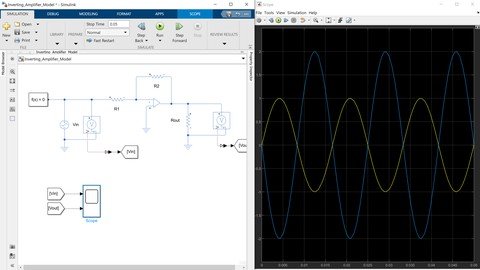
Genre: eLearning | MP4 | Video: h264, 1280×720 | Audio: AAC, 48.0 KHz
Language: English | Size: 2.36 GB | Duration: 7h 55m
Learn to simulate analog and digital electronics circuits in MATLAB/Simulink such as amplifiers, filters, ADC, and DACs
What you’ll learn
How to simulate analog electronics and digital electronics in MATLAB/Simulink
How to add passive and active electronics components to models in MATLAB/Simulink
How to build electronics amplifiers in MATLAB/Simulink
How to build digital electronics circuits in MATLAB/Simulink
How inverting and non-inverting electronics amplifiers work
How to design active electronics filters and how to simulate them in MATLAB/Simulink
MATLAB/Simulink electronics models provided so you can follow along and use for your own designs
Electronics and Electrical Engineering Simulations in MATLAB/Simulink
How analog-to-digital converters (ADCs) and digital-to-analog converters (DACs) work and how to simulate them in MATLAB/Simulink
Description
This course is designed to allow you to simulate any analog or digital electronics device in MATLAB/Simulink, including active low-pass filters, active high-pass filters, audio equalizers, inverting amplifiers, non-inverting amplifiers, analog-to-digital converters (ADCs), and digital-to-analog converters (DACs). This course not only gives a review of the theory of how different electronics devices work, such as amplifiers, filters, ADCs, and DACs work, but also gives several examples on how to simulate these electronics devices using MATLAB/Simulink. The MATLAB/Simulink models for the analog electronics and digital electronics devices created during the lectures are available for download with each lecture. The course is divided into the following sections:
1. Introduction to MATLAB/Simulink for Analog and Digital Electronics: in section 2 of the course, we will begin by reviewing the passive and active components commonly used in electronics. We will then install MATLAB/Simulink’s free trial version, and will discuss how to find components in the library browser, how to add them to models, and how to build the models and run simulations.
2. Analog Electronics Simulations in MATLAB/Simulink: in section 3 of the course we will be focusing on the simulation of analog electronics. We will begin by reviewing the theory of inverting and non-inverting amplifiers using op-amps and will be simulating these electronics circuits. We will then review low-pass and high-pass filters and will be simulating these circuits. We will end the section with two projects. In the first project, we will design an audio equalizer. In the second project, we will be designing a full-wave power electronics rectifier circuit commonly used in power supplies.
3. Digital Electronics Simulations in MATLAB/Simulink: in section 4 of the course we will be focusing on the simulation of digital electronics. We will begin by reviewing how analog-to-digital converters (ADCs) work and will then simulate these devices. After this, we will also review the theory and simulate digital-to-analog converters (DACs). We will also be building and simulating combinational and sequential digital circuits. We will work on two projects, one for each type of circuit. In the combinational circuits project, we will be building a circuit that detects a combination of three consecutive logic 1s in a string of eight bits. In the sequential circuits project, we will be designing a garage door opener.
As mentioned above, in each section, we will go over several models to illustrate how we can design and simulate electronics devices in MATLAB/Simulink. The models are also available for download so that you can follow along, as well as use these models and modify them to create your own designs.
By learning how to simulate analog electronics and digital electronics devices in MATLAB/Simulink, you will be able to further your career in electrical engineering and electronics design.
Remember that Udemy offers a 30-day money-back guarantee. I am also always available for questions while you go through the course to ensure everything is clear.
See you in the course!
Who this course is for:
Engineering students
Practicing engineers
Anybody with an interest in learning about electronics and/or MATLAB/Simulink
Password/解压密码www.tbtos.com
转载请注明:0daytown » MATLAB/Simulink for Analog and Digital Electronics